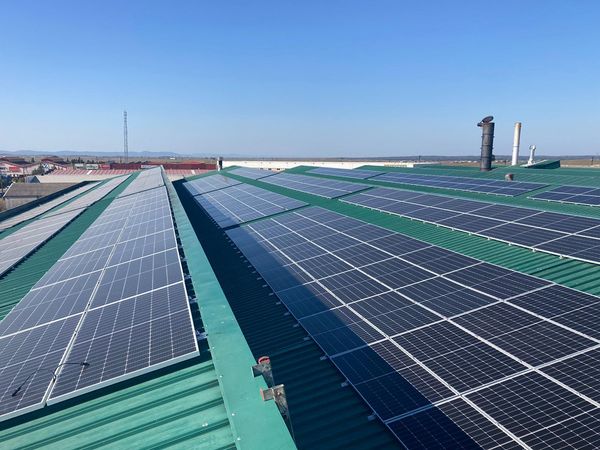全球个人和公司之间的环境意识的明显增长使太阳能成为我们现代最受欢迎的清洁能源之一. 太阳能板, 具体来说, 由于它利用了地球上最丰富的能源,因此在住宅和商业建筑中越来越流行: 太阳. 但是您是否想知道这些面板如何工作将阳光转化为电力? 乍一看,太阳能技术似乎很复杂, 但是了解基础知识可以帮助您欣赏使太阳能电池板成为世界上最常见的可再生能源之一的进步.
太阳能电池板如何工作?
太阳能电池板使用一个简单的过程,涉及从太阳收集能量,然后将其转换为电力. 它背后的科学令人着迷,并且基于某些材料吸收和转化光能的能力. 虽然太阳能电池板背后的技术可能会出现新颖, 已经存在一段时间了, 近年来,在设计和制造过程中取得了重大进步.

1. 太阳能电池板从太阳的光线中捕获能量.
太阳能电池板是一种将阳光转化为电能的技术. 具体来说, 太阳能光伏 (光伏发电) 面板是用于发电的最常见的太阳能电池板. 这些面板由多个太阳能电池组成,这些太阳能电池由称为半导体的材料组成. 当阳光撞击这些细胞时, 它使电子从它们的原子松散, 导致电流流动. 细胞相互连接, 创建一个较大的电路,该电路可以产生足够的能量供实际使用. 从那里, 电流通常被馈入称为逆变器的设备, 它将直流电转换为 (直流电) 太阳能电池板生产成交流电流 (空调) 与电网兼容. 最终, 太阳能电池板是一种可持续能源解决方案,可以帮助减少碳排放并促进更大的能源独立性.
2. 光伏电池将阳光转化为直流 (直流电) 电.
太阳能电池板系统的主要组件之一是光伏 (光伏发电) 细胞. 这些细胞由半导体材料制成, 例如硅, 具有独特的电性能. 当阳光照射到光伏电池上时, 光线的能量被半导体材料吸收, 导致电子从其原子中敲开. 这会产生电子流, 或电流, 可以收集并用作电力. 为了使这种电力可用, 电流必须首先从直流电流转换 (直流电) 交流电流 (空调) 使用逆变器. 一旦转换, AC电力可用于为房屋和企业供电. 全面的, PV细胞是太阳能电池板系统的关键部分, 因为他们负责将阳光转化为可用的电力.
3. 逆变器将直流电转换为交替电流 (空调) 电.
通过太阳能电池板将阳光转换为可用能量的过程可以分解为几个关键步骤. 这样的步骤涉及使用逆变器, 在转换直流电流中起着至关重要的作用 (直流电) 电流到交流电流 (空调) 电. 这很重要,因为大多数家用电器和电子设备都在交流电上运行. 所以, 太阳能电池板生产的能量必须转换为AC电力,以便为房屋和企业供电. 逆变器有不同的尺寸和功率等级, 允许它们针对特定的太阳能电池板系统量身定制. 逆变器的效率也是考虑的关键因素, 因为它直接影响太阳能电池板系统可以生产的电量.
4. 然后,太阳能被输送到电源网络中.
一旦太阳能电池板吸收阳光, 将其转换为电力的过程开始. 然后将面板生产的直流电力发送到逆变器, 将其转化为可用于家庭的交流电力. 如果产生的电力超过所需的金额, 网格连接的系统将多余的电网馈入电网, 允许其他用户访问它. 随着时间的推移, 这种过多的能量被归功于能源账单, 反过来降低了总体能源成本. 所以, 太阳能被输入电力网络, 为群众提供清洁可再生的能源, 减少对传统能源的依赖, 并帮助遏制污染水平.
5. 电力可用于家庭或企业.
太阳能电池板是一种有效且可再生的能源,可以将阳光转化为电力. 该过程始于太阳能电池板的光伏电池吸收太阳辐射. 这些单元包含半导体材料, 例如硅, 暴露于阳光时会产生电场. 当阳光撞到细胞时, 它使电子从它们的原子松散, 允许它们自由流经半导体材料并产生电流. 该电流由接线系统捕获,然后发送到转换直流电流的逆变器 (直流电) 太阳能电池板生产的电力交流电流 (空调) 可以在家庭或企业中使用的电力. 从那里, 电力可以为各种设备供电, 包括灯, 电器, 和电子产品. 全面的, 太阳能电池板提供了绿色和可持续的能源,可以帮助客户节省其能源账单的钱,同时还可以减少碳足迹.
6. 任何未使用的电力都可以回到网格.
太阳能电池板的主要优点之一是它们能够在不产生任何温室气体的情况下为家庭或商业用途发电. 而且, 产生的任何多余的电力都可以回到网格中, 允许财产所有人赚取学分,甚至由其公用事业公司付款. 这个过程, 被称为净计量, 使太阳能电池板所有者能够通过超出其使用的能量来抵消其电费. 多余的能量被发送回电网, 这使其他公用事业客户可以使用该电源,而太阳系所有者的仪表继续向后运行 - 进一步降低了能源成本. 全面的, 净计量确保太阳能电池板系统产生的任何未使用的电力都不会浪费, 最终导致更绿色,更可持续的能源未来.
7. 太阳能电池板通常安装在接收阳光直射的区域的屋顶上.
关于太阳能电池板, 适当的安置对于它们的有效性至关重要. 一般来说, 太阳能电池板通常安装在接收阳光直射的区域的屋顶上. 这是因为太阳能电池板通过将光能从太阳转换为可用的电能来起作用. 因此, 面板全天接收的阳光更直接, 他们能产生的能量越多. 如果面板安装在阴影区域或远离阳光下, 他们将无法产生那么多的电力. 适当的放置考虑到屋顶的角度和方向, 附近的树木或可能施放阴影的建筑物的位置, 以及面板全天收到的阳光量. 与正确的位置, 太阳能电池板可以为电力房屋和企业提供干净可持续的能源.
8. 太阳能电池板的效率受天气和太阳能电池板的角度的影响.
太阳能电池板的效率是采用太阳能时要考虑的关键方面. 太阳能电池板可以产生的电量取决于几个因素, 包括天气条件和太阳能电池板的角度. 天气会影响到达太阳能电池板的阳光. 在多云, 阴天或多雨的天气, 阳光的量可能会大大降低, 降低太阳能电池板的效率. 温度的变化还会影响太阳能电池板的性能, 高温导致效率降低. 太阳能电池板的角度在确定其效率方面也起着至关重要的作用. 太阳能电池板的最佳定位和倾斜度确保它们吸收最大的阳光. 因此, 放置在朝向太阳的完美方向的太阳能电池板比以尴尬的角度放置的电力更多. 保持太阳能电池板的最佳角度和位置对于实现太阳能电池板系统的最高效率至关重要.
综上所述, 太阳能电池板为世界提供了传统电源的绝佳替代品. 它们通过吸收阳光并将其转换为可用的电力来起作用. 该过程可能涉及许多科学和工程概念, 但是总体想法是简单且可持续的. 此外, 太阳能电池板是环保的,有助于减少碳足迹. 随着技术的不断进步, 太阳能变得越来越有效和成本效益, 对于许多家庭和企业来说,它是一个有吸引力的选择. 了解太阳能电池板的工作方式只是采用这种可再生能源解决方案的第一步.
如果您对太阳能发电有更多疑问或有兴趣在您的家庭或企业中采用太阳能技术, 我们在这里随时提供支持和答案. GYCX太阳能致力于为客户提供可持续和高效的太阳能解决方案. 随时接触我们, 我们的专业团队将致力于为您提供定制的能源解决方案, 帮助您迈向更清洁,环保的能量未来. 让我们一起努力建立更绿色的明天!
不要忘记在我们的Facebook页面上与我们建立联系! 关注GYCX太阳能以获取最新更新, 利用太阳能的提示, 并参与我们社区中的讨论. 我们邀请您在Facebook上加入我们, 您可以在这里探索我们对我们对可持续能源的承诺并与同伴互动的承诺. 访问我们的页面, 喜欢, 并跟随我们与令人兴奋的太阳能世界保持联系.
